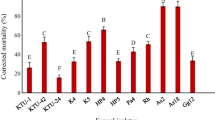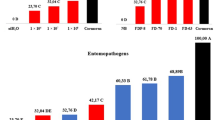Abstract
Esteya vermicola is an endophytic fungus of pine wood nematode(s) (PWN) Bursaphelenchus xylophilus and a promising biocontrol agent. However, until now, only the lunate spores of E. vermicola have been demonstrated to be highly effective against pine wilt disease. In the present study, blastospores of E. vermicola were successfully used as a biocontrol agent through injection into large pine trees in Aewol-eup, Jeju, South Korea. When pine trees were injected with a 6–8 mL blastospore suspension of E. vermicola (108 mL−1) 1 month before inoculating them with PWN, 73.77% of the trees remained alive after one year. When injected with blastospores of E. vermicola 2 and 4 weeks after PWN infection, 40% of the trees were saved. As a control, the pine trees inoculated with PWN only all died. Moreover, a hypothesis of the mechanism of biocontrol within the pine tree was proposed based on the population density of PWN over time along with the presence of E. vermicola in the pine tree. The hypothesis involved a cycle that included the growth of E. vermicola without PWN infection, attraction and adhesion to PWN, movement and death of infected PWN, production of a second generation of lunate spores, and attraction of other migratory PWN.





Similar content being viewed by others
References
Aćimović, S. G., McGhee, G. C., Sundin, G. W., & Wise, J. C. (2015a). Control of fire blight (Erwinia amylovora) on apple trees with trunk-injected plant resistance inducers and antibiotics and assessment of induction of pathogenesis-related protein genes. Frontiers in Plant Science, 6, 16.
Aćimović, S. G., McGhee, G. C., Sundin, G. W., & Wise, J. C. (2015b). Evaluation of trunk-injected bactericides and prohexadione-calcium for Environmentally friendly control of fire blight (Erwinia amylovora) in apples. Proceedings of the VII Congress on Plant Protection: Integrated Plant Protection–a Knowledge-Based Step towards Sustainable Agriculture, Forestry and Landscape Architecture 2014.
Baermann, G. (1917). Eine einfache methode zur auffindung von Ancylostomum (Nematoden) larven in erdproben. Geneeskd Tijdschr Ned Indie, 57, 131–137.
Bick, E. N., Haugen, C., Bernick, S., & Herms, D. A. (2017). Efficacy of soil and trunk applied systemic insecticides for three years after application for control of emerald ash borer (Coleoptera: Buprestidae) on green ash. Arthropod Management Tests, 42(1), tsw134.
Davis, M. J., & Elkinton, J. S. (2018). Efficacy of two systemic insecticides with stem gall wasp, Zapatella davisae (Hymenoptera: Cynipidae) on black oak. Journal of Economic Entomology, 111(2), 986–988.
Du, T., Zhang, Y. A., Wang, Y. Z., Qu, L. J., Wang, Q. H., & Li, Z. L. (2014). Infectivity test on Esteya vermicola conidia against pine wood nematode. Forest Research, 27(2), 174–178.
Fukuda, K. (1997). Physiological process of the symptom development and resistance mechanism in pine wilt disease. Journal of Forest Research, 2(3), 171–181.
Futai, K. (2008). Pine wilt in Japan: From first incidence to the present. In Pine wilt disease (pp. 5-12): Springer.
Kwiko Kuroda, A. K. (2016). Rish of killing uninfected pine trees by the repeated trunk-injection of nematicides to prevent pine wilt, 2016 IUFRO Working Party 7.02.10 Pine Wilt Disease International Symposium. Seoul, Korea.
Lin, F., Ye, J., Wang, H., Zhang, A., & Zhao, B. (2013). Host deception: Predaceous fungus, Esteya vermicola, entices pine wood nematode by mimicking the scent of pine tree for nutrient. PLoS One, 8(8), e71676.
Liou, J. Y., Shih, J. Y., & Tzean, S. S. (1999). Esteya, a new nematophagous genus from Taiwan, attacking the pinewood nematode (Bursaphelenchus xylophilus). Mycological Research, 103(2), 242–248.
Ma, T., Shi, X. H., Shen, J., et al. (2018). Field evaluation of commercial attractants and trap placement for monitoring pine sawyer beetle, Monochamus alternatus (Coleoptera: Cerambycidae) in Guangdong, China. Journal of Economic Entomology, 111(1), 239–246.
Shin, S. C., & Han, H. R. (2006). Current status on research and management of pine wilt disease in Korea. Paper presented at the proceedings of the international symposium on current status on research and management of pine wilt disease. Korea: Seoul.
Togashi, K., & Matsunaga, K. (2004). A simple method for discriminating Bursaphelenchus xylophilus and B. mucronatus by species-specific polymerase chain reaction primer pairs. Nematology, 6(2), 273–277.
VanWoerkom, A. H., Aćimović, S. G., Sundin, G. W., Cregg, B. M., Mota-Sanchez, D., Vandervoort, C., et al. (2014). Trunk injection: An alternative technique for pesticide delivery in apples. Crop Protection, 65, 173–185.
Vicente, C., Espada, M., Vieira, P., & Mota, M. (2012). Pine wilt disease: A threat to European forestry. European Journal of Plant Pathology, 133(1), 89–99.
Wang, C. Y., Fang, Z. M., Sun, B. S., Gu, L. J., Zhang, K. Q., & Sung, C. (2008). High infectivity of an endoparasitic fungus strain, Esteya vermicola, against nematodes. The Journal of Microbiology, 46(4), 380–389.
Wang, C. Y., Fang, Z. M., Wang, Z., Gu, L. J., Sun, B. S., Zhang, D. L., et al. (2009a). High infection activities of two Esteya vermicola isolates against pinewood nematode. African Journal of Microbiology Research, 3(10), 581–584.
Wang, C. Y., Wang, Z., La Lee, M., Li, Z., Zhang, D. L., Liu, L., et al. (2009b). Attraction of pinewood nematode, Bursaphelenchus xylophilus, to the endoparasitic fungus Esteya vermicola. African Journal of Microbiology Research, 3(11), 782–786.
Wang, C. Y., Wang, Z., Fang, Z. M., Zhang, D. L., Gu, L. J., Liu, L., & Sung, C. K. (2010). Attraction of pinewood nematode to Endoparasitic Nematophagous fungus Esteya vermicola. Current Microbiology, 60(5), 387–392.
Wang, C. Y., Fang, Z. M., Wang, Z., Zhang, D. L., Gu, L. J., Lee, M. R., et al. (2011a). Biological control of the pinewood nematode Bursaphelenchus xylophilus by application of the endoparasitic fungus Esteya vermicola. BioControl, 56(1), 91–100.
Wang, Z., Wang, C. Y., Yang, Z. H., Fang, Z. M., Moon, Y. J., Sun, B. S., & Sung, C. (2011b). Viability and pathogenicity of Esteya vermicola in pine trees. Biocontrol Science and Technology, 21(4), 387–393.
Wang, Y., Yang, Z., Yu, J., Zhang, Y., Xue, J., Li, Z., Li, J. J., Wang, C. Y., Wang, Z., Hou, J. G., Begum, S., Gu, L. J., Lee, M. R., & Sung, C. K. (2013). Comparison between conidia and blastospores of Esteya vermicola, an endoparasitic fungus of the pinewood nematode, Bursaphelenchus xylophilus. World Journal of Microbiology and Biotechnology, 29(12), 2429–2436.
Wang, R., Dong, L., Chen, Y., Qu, L., Wang, Q., & Zhang, Y. (2017a). Esteya Vermicola, a Nematophagous fungus attacking the pine wood nematode, harbors a bacterial Endosymbiont affiliated with Gammaproteobacteria. Microbes and Environments, 32(3), 201–209.
Wang, Z., Zhang, Y., Wang, C., Wang, Y., & Sung, C. (2017b). Esteya vermicola controls the pinewood nematode, Bursaphelenchus xylophilus, in pine seedlings. Journal of Nematology, 49(1), 86–91.
Wang, C. Y., Yin, C., Fang, Z. M., Wang, Z., Wang, Y. B., Xue, J. J., et al. (2018). Using the nematophagous fungus Esteya vermicola to control the disastrous pine wilt disease. Biocontrol Science and Technology, 28(3), 268–277.
Xue, J., Hou, J., Zhang, Y., Wang, Y., Lee, M., Yu, J., & Sung, C. K. (2014). Optimization of promoting conidial production of a pinewood nematode biocontrol fungus, Esteya vermicola using response surface methodology. Current Microbiology, 69(5), 745–750.
Yin, C., Wang, Y., Zhang, Y., Wang, H., Tao, R., Li, Y., & Sung, C. K. (2019). A pine wood sample preparation method for high target and quality DNA extraction for detection of Esteya vermicola by PCR from living pine. Journal of Basic Microbiology, 59(4), 437–441.
Zhao, B. G. (2008). Pine wilt disease in China. In Pine wilt disease (pp. 18-25): Springer.
Zhao, B. G., Futai, K., Sutherland, J. R., & Takeuchi, Y. (2008). Pine wilt disease: Springer.
Acknowledgements
This research was funded by the National Natural Science Foundation of China (NSFC) under grant 31300545, and the Ministry of Science and Technology of the People’s Republic of China under grant 2017YFD0600102.
Author information
Authors and Affiliations
Corresponding author
Ethics declarations
The authors declare no conflict of interest. This article does not contain any work conducted on animal or human participants. Informed consent was not applicable to this article since no information regarding individual participants was included in the study.
Rights and permissions
About this article
Cite this article
Yin, C., Wang, Y., Zhang, Ya. et al. Hypothesized mechanism of biocontrol against pine wilt disease by the nematophagous fungus Esteya vermicola. Eur J Plant Pathol 156, 811–818 (2020). https://doi.org/10.1007/s10658-019-01930-9
Accepted:
Published:
Issue Date:
DOI: https://doi.org/10.1007/s10658-019-01930-9




